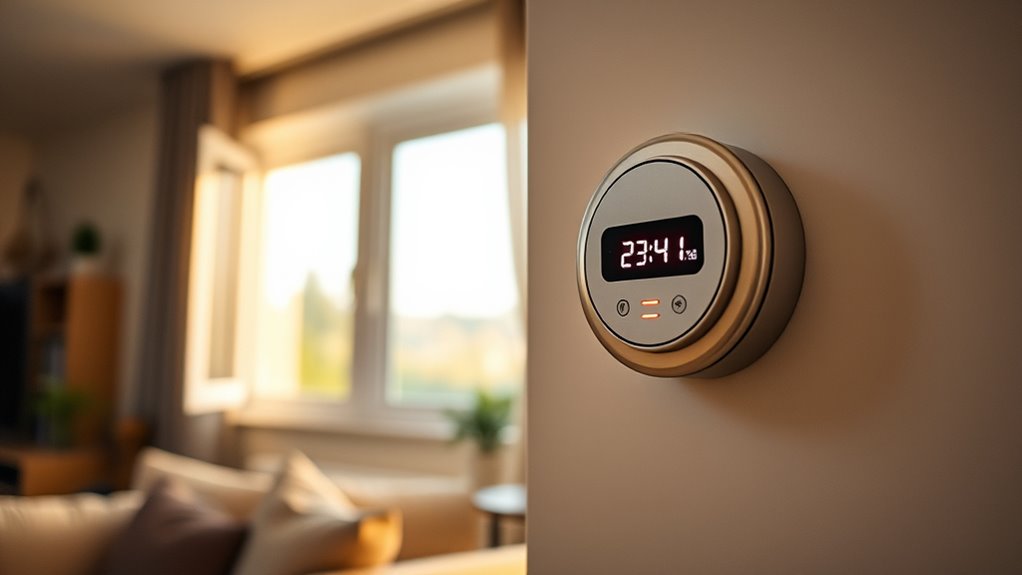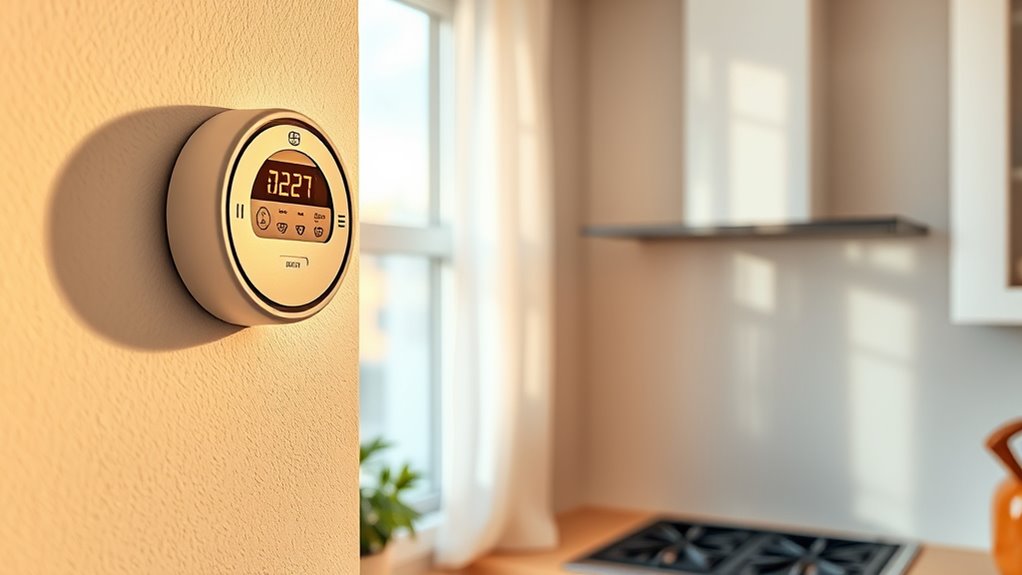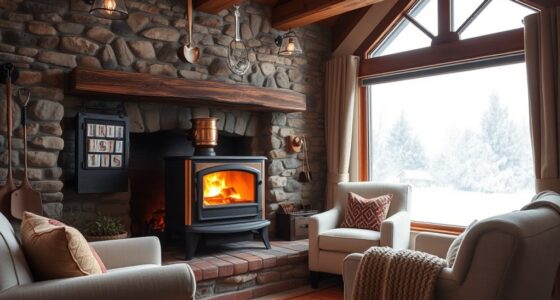To stay safe from carbon monoxide risks, you must use detectors properly and guarantee good ventilation. Install CO detectors near sleeping areas, on each floor, and near appliances, and test them monthly. Regularly maintain your appliances to prevent leaks, and avoid blocking vents or air intakes. Never run gas-powered tools inside, and open windows or use exhaust fans during appliance use. Keep these practices in mind—learning more can further protect you and your loved ones.
Key Takeaways
- Proper placement and regular testing of CO detectors are vital for early warning of dangerous CO buildup.
- Regular maintenance of appliances prevents malfunctions that can release CO into indoor air.
- Effective ventilation, including exhaust fans and open windows, helps disperse CO and reduces health risks.
- Never block vents or air intakes, and avoid running generators or grills indoors to prevent CO accumulation.
- Combining detector use, routine appliance maintenance, and proper ventilation minimizes carbon monoxide poisoning risks.

Have you ever wondered how dangerous carbon monoxide truly is? It’s a silent threat lurking in your home, often unnoticed until it’s too late. That’s why understanding indoor air safety is vital. Carbon monoxide is an odorless, colorless gas that comes from appliances like furnaces, water heaters, and gas stoves. If these appliances aren’t properly maintained, they can produce dangerous levels of CO. Regular appliance maintenance becomes your first line of defense. Scheduling annual inspections ensures that vents are clear, combustion is complete, and ventilation systems work efficiently. When appliances malfunction or are improperly installed, they release carbon monoxide directly into your indoor air, putting everyone in your household at risk.
Carbon monoxide is a silent, odorless threat from appliances—regular maintenance and inspections are vital for safety.
To protect yourself, you need more than just maintenance—installing reliable CO detectors is indispensable. These devices act as your early warning system, alerting you before CO levels become dangerous. Place detectors near sleeping areas, on each floor of your house, and close to appliances that may emit CO. Remember, detectors only work if they’re functioning properly, so test them monthly and replace batteries regularly. It’s a simple step that can save lives by giving you time to evacuate or ventilate your home when CO levels spike.
Ventilation plays a vital role in maintaining indoor air safety. Proper airflow helps disperse any build-up of carbon monoxide, especially in tight or poorly ventilated spaces. When you operate gas appliances, make sure the area is well-ventilated. Use exhaust fans, open windows, or install vents to promote continuous airflow. Good ventilation not only reduces the risk of CO accumulation but also improves overall indoor air quality, making your living space healthier. Don’t forget that stove hoods and bathroom fans are effective tools when used correctly, especially during and after appliance use.
Your daily habits can also influence indoor air safety. Never block vents or air intakes, and avoid running appliances like generators or charcoal grills inside your home or garage. These produce dangerous CO levels quickly. Be vigilant about appliance maintenance—clean filters, check for leaks, and listen for unusual noises. If you notice any signs of improper appliance operation, shut the appliance off immediately and call a professional. Taking these steps guarantees your home remains a safe environment, drastically reducing the risk of carbon monoxide poisoning. Ultimately, combining vigilant appliance maintenance, reliable detectors, and good ventilation will help keep your indoor air safe and your loved ones protected. Additionally, awareness of cybersecurity vulnerabilities related to smart home devices can help prevent digital threats that could compromise your safety.
Frequently Asked Questions
How Often Should Carbon Monoxide Detectors Be Replaced?
You should replace your carbon monoxide detectors every 5 to 7 years, depending on the manufacturer’s recommendation. Regular detector maintenance includes testing monthly and replacing batteries annually. Follow your replacement schedule closely to guarantee continuous safety. If your detector chirps or malfunctions before the recommended time, replace it immediately. Staying on top of your detectors’ maintenance and replacement schedule helps keep your home safe from carbon monoxide risks.
Can Plants Reduce Indoor Carbon Monoxide Levels?
Did you know that some plants can reduce indoor air pollutants? While they don’t specifically target carbon monoxide, certain species like snake plants and pothos aid in indoor air purification by absorbing toxins. Choosing the right plant species can improve overall air quality, but don’t rely solely on plants for CO reduction. Make certain there is adequate ventilation and use detectors for safety. Plants complement ventilation efforts but shouldn’t replace them.
Are There Specific Ventilation Systems Recommended for High-Risk Areas?
Yes, for high-risk areas, you should install specialized ventilation systems like exhaust fans, make-up air units, or HRVs to improve airflow. These systems help decrease carbon monoxide buildup effectively. Additionally, consider high-risk area modifications, such as sealing leaks and ensuring proper appliance placement. Regular maintenance and proper installation of these ventilation system types guarantee safety, keeping indoor air quality high and minimizing health risks.
What Are the Symptoms of Long-Term Low-Level Carbon Monoxide Exposure?
You might not notice chronic exposure to low-level carbon monoxide, but subtle symptoms can reveal the danger. Fatigue, headaches, dizziness, and shortness of breath often appear gradually, making symptom recognition vital. Over time, you could experience memory issues or mood changes, signaling that your body’s warning system is compromised. Stay alert—long-term low-level exposure can silently damage your health, so understanding these signs could save your life.
How Can I Prevent Carbon Monoxide Buildup During Power Outages?
During power outages, you can prevent carbon monoxide buildup by practicing generator safety and using alternative heating methods properly. Always operate generators outdoors, far from windows and vents, to guarantee exhaust gases don’t enter your home. When using alternative heating, ensure proper ventilation and avoid idling vehicles indoors. Regularly maintain your heating equipment and never use unvented appliances indoors. These steps help keep your home safe from dangerous CO accumulation.
Conclusion
To keep your home safe, it’s wise to stay attentive to carbon monoxide risks. Installing detectors and ensuring proper ventilation are gentle reminders that your well-being is always a priority. By taking these simple steps, you’re quietly safeguarding your loved ones without much fuss. Remember, a little caution goes a long way in preventing unseen dangers. Staying proactive isn’t just smart—it’s a quiet act of care that helps keep your home peaceful and secure.











